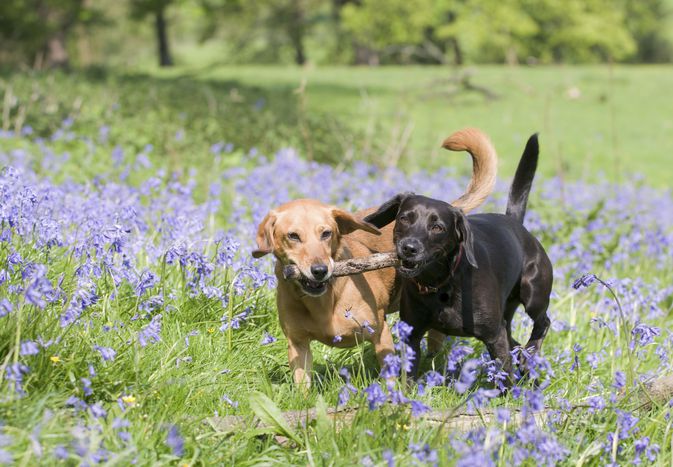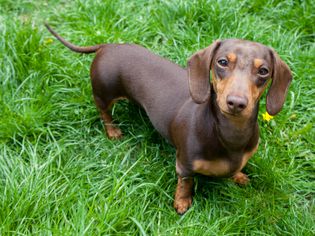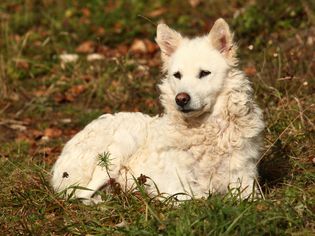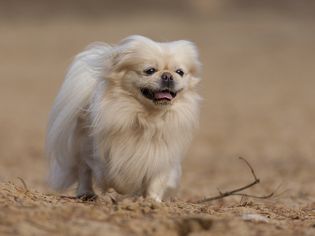A mainstay of traditional British fox hunts, fox terriers are small-to-medium dogs from England with long faces, short legs, and either wiry or smooth coats. This strong, short-backed hunting breed has a distinctive expression.
While they possess typical terrier traits of feistiness and a powerful prey drive, fox terriers are a great match for those seeking playful, amusing companions with big personalities. They are known for both their sense of humor and intelligence. Their athletic, graceful features also make them master show dogs.
Learn more about the playful and active fox terrier.
Breed Overview
Group: Terrier
Weight: 15 to 18 pounds
Height: 14 to 15.5 inches
Coat: Smooth or wired
Coat Color: White with black or tan, black-and-tan mix
Life Span: 12 to 15 years
Temperament: Playful, bold, intelligent, active, courageous
Hypoallergenic: Yes (Wire Fox Terrier), No (Smooth Fox Terrier)
Origin: England
Characteristics of the Fox Terrier
Like other terrier breeds, the fox terrier is known for funny antics and a spirited personality. These dogs have plenty of courage packed into their small size thanks to their origins in hunting, which also makes them likely to be fearless with other animals (both large and small).
A fox terrier can be a great companion dog for adults and children, but because of the breed's high prey drive, they might not be suitable for living with cats or other dogs. Also, with plenty of energy and enthusiasm, these dogs love playing and do best with families that are prepared to provide them with plenty of exercise.
What’s unique about this breed is that there are actually two fox terriers—one is known as the wire fox terrier and the other is the smooth fox terrier, based upon the texture of their coats. Another distinguishing physical trait is the head: a smooth fox terrier's head is more V-shaped. Otherwise, the two breeds are essentially identical.
| Affection Level | Medium |
| Friendliness | Medium |
| Kid-Friendly | High |
| Pet-Friendly | Medium |
| Exercise Needs | Medium |
| Playfulness | High |
| Energy Level | High |
| Trainability | Medium |
| Intelligence | High |
| Tendency to Bark | Medium |
| Amount of Shedding | Low |
History of the Fox Terrier
These bold, courageous dogs originated in the late 1700s during the heyday of British fox hunts. Fox terriers have coats that are predominantly white with a mixture of black or tan markings, bred specifically without red fur so the hunting dogs could avoid being mistaken for foxes.
It was this dog's job to coax the fox from their lair, allowing the hounds and horsemen to begin their pursuit. They would essentially harass the fox by growling and lunging until they retreated from their hole.
Fox hunting is now banned in England, but it was a passion of the British gentry for generations. These hunts consisted of full-dress events marked by pageantry and ritual with eager terriers riding in saddlebags. These dogs were specifically bred to “go to ground”—that is, to chase small game from their dens.
It’s believed that the wire fox terrier descended from the rough coated terrier and tan terrier, while the smooth fox terrier is considered a mix between Old English terriers, smooth-coated black and tan terriers, bull terriers, greyhounds, and beagles.
Both the wire and smooth fox terriers are successful show dogs with more than a dozen Westminster Kennel Club "Best in Show" awards. Matford Vic, a wire purchased from a farmer for only 10 dollars, won Westminster in both 1915 and 1916. Known as the “gentleman of the terrier world,” a smooth fox terrier was named "Best in Show" three years in a row from 1907 to 1909.
In England, both wire and smooth fox terriers have been recognized as separate breeds since the late 19th century, and the AKC recognized them as distinct breeds in 1985. Though the wire fox terrier is considered the more recent variety, historic paintings suggest both coat types have been around since the mid-18th century. Interbreeding of smooth and wire fox terriers ceased in the early 1900s.
Among the many well-known fox terriers of history was Caesar, the favorite dog of King Edward VII. Herbert Hoover had two fox terriers known as Big Ben and Sonnie. The breed became especially popular in the 1930s and 1940s thanks to Asta, co-star of William Powell and Myrna Loy in The Thin Man movies. The breed’s looks, features, and natural skill to perform have made these dogs a familiar presence in both movies and television.

Fox Terrier Care
Fox terriers can live happy, well-adjusted lives with the proper care. Ensure your dog is allowed plenty of exercise along with training and socialization. When it comes to grooming, their needs depend on coat type and whether they will perform in dog shows.
Exercise
Like most terriers, the fox terrier requires an ample amount of daily exercise (about 30 to 45 minutes per day) to stay mentally and physically fit. This breed is known for boundless energy, which can become a hassle inside the house when they aren't allowed enough activity.
Because of their strong prey drive, these dogs require leashed walks and supervised play in safely fenced-in areas. This instinct also means that your fox terrier will love to chase, so throwing a ball in the yard is a great way to provide entertainment.
Grooming
Grooming a wire fox terrier will depend on whether your dog is a show dog or a family companion. Showing these dogs will require hand-stripping the coat, while a pet’s coat can be clipped into a trim with minimal effort. Though they are not big shedders, wire foxes will require regular brushing to avoid matting in their coarse, hypoallergenic coats.
The smooth fox terrier’s hard, dense coat should be groomed weekly with a thick brush to remove shedding hair.
Fox terriers should have their nails trimmed monthly and ears checked weekly.
These dogs also have a penchant for digging, so while a monthly bath is generally sufficient, more frequent bathing may be required if they gain access to a garden or mud in the backyard.
Training
Training these spunky, playful dogs will require a great deal of consistency and patience, but it also helps to have a sense of humor. Although the breed is highly intelligent, they are also independent and easily bored, so training sessions must be kept brief, positive, and engaging.
Proper socialization is a necessity. Some fox terriers can become jealous or aggressive towards other pets in the home.
As potential show dogs, they are highly adept for performance events like agility sports that require athleticism, speed, and intelligence. Naturally alert, they also tend to make excellent watchdogs.
Common Health Problems
Fox terriers are generally healthy dogs, although they have been associated with some common problems that potential owners should be aware of. To help ensure your dog lives a long, healthy life, adopt from a responsible breeder that provides the medical history of your new puppy's parents.
Genetic conditions of the fox terrier include:
- Cataracts: Cataracts are an eye issue that causes your dog's eyes to appear milky or cloudy. Surgery may be recommended by your veterinarian to remove cataracts.
- Primary lens luxation (PLL): Another eye condition, PLL affects the lens of your dog's eye and eventually leads to blindness.
- Glaucoma: This painful disease changes the pressure inside your dog's eye. If your dog shows signs of glaucoma, consult your veterinarian early on to prevent further deterioration.
- Elbow and hip dysplasia: While dysplasia is typically associated with large breeds, fox terriers may also develop this malformation in the elbow or hip joints that impairs movement.
- Luxating patella: This condition can cause your dog's knee to slip out of its joint.
- Wobbler syndrome: Suggested by its name, wobbler syndrome is a neurological disease occurring in the neck that makes dogs wobble or have difficulty moving around.
Diet and Nutrition
The fox terrier should perform well with high-quality commercial or home-prepared (under veterinary supervision) dog food, typically about two cups per day. A diet with plenty of protein is recommended. Fresh, clean water should be available at all times for this active and playful breed.
This breed is prone to becoming overweight or developing canine obesity, so limit your dog's food consumption to a healthy amount. Talk with your veterinarian to determine an appropriate portion schedule based on your specific dog's age, weight, and activity level.
Where to Adopt or Buy a Fox Terrier
Fox terrier puppies typically cost between $1,000 and $2,000, but prices may be higher depending on pedigree and availability.
If you're interested in adopting this breed, check your local animal shelters and rescue groups for fox terriers in need of a forever home. There are plenty of terrier breeds waiting for loving families that can be great companions.
When buying a puppy, research breeders in your area to ensure your new best friend comes from one that provides genetic testing and comfortable living conditions for their dogs.
To start your search, check out these resources for fox terrier rescues and American Kennel Club breeders:
- American Fox Terrier Rescue
- Wire Fox Terrier Rescue Midwest
- AKC Wire Fox Terrier Breeders
- AKC Smooth Fox Terrier Breeders
Fox Terrier Overview
The fox terrier is a high-energy dog who enjoys being active. They have a high prey drive, so they may not be suitable for homes with other pets, but they can make lovely pets for households with children. As with other dog breeds, proper training and socialization are necessary.
Pros of Fox Terriers
- Intelligent and trainable
- Playful personality
- Great family dog for kids
Cons of Fox Terriers
- Needs considerable exercise
- Might become aggressive without socialization
- Shouldn't be off-leash

More Dog Breeds and Further Research
It's best to research before choosing a dog breed to find the best fit for your home. Talk to other fox terrier owners, reputable breeders, and rescue groups to learn more.
If you’re interested in similar dogs, check out these terrier breeds:
- Soft-Coated Wheaten Terrier
- Cesky Terrier
- Sealyham Terrier
There are plenty of dog breeds to suit all types of people. With a little research, you can discover a great breed to join your family!
- Are fox terriers good pets?
Fox terriers have a devoted following thanks to their unique personalities and fun antics. However, they're best-suited for experienced dog parents who can commit to their exercise and training needs. This breed does well with children and can be a wonderful family pet with proper care.
Are fox terriers aggressive?Fox terriers are usually very friendly with adults and children, but they have been known to become jealous of other dogs. Because of their high prey drive, these dogs may also be aggressive toward cats and small pets.
What's the difference between a fox terrier and a Jack Russell?While the two breeds share some common lineage, fox terriers are larger and have slimmer faces than Jack Russell terriers. Smooth fox terriers can resemble Jack Russells thanks to their similar coats, but the wire fox terrier's fur is coarser.








